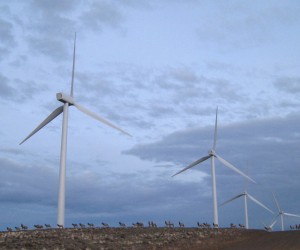In the year that wind power helped to keep South Africa’s lights on at a cost less than zero (see CSIR ref: below), approximately five hundred international and local delegates will gather in Cape Town’s CTICC on 4-5 November to discuss the accomplishments, challenges and future of South Africa’s flourishing wind energy sector. The Minister of Energy the Honourable Tina Joemat-Petterssen is the patron of the event and will be opening it.
“In a narrow sense we as SA Incorporated are electricity constrained and we must plot how wind power can best contribute to further alleviating this challenge”, explains Heather Sonn, Chair of the South African Wind Energy Association, the custodian of Windaba. “In the broad sense…”, she continues, “… the country through the National Development Plan is driving at a developmental state based on a public private partnership that delivers sustainable development from the ground up. This is exactly what is happening in the wind sector in South Africa. Therefore the conference theme: ‘Powering the winds of change’.”
Sonn’s assertions are clearly supported by the facts. As a consequence of a world class procurement programme the Renewable Energy Independent Power Producer’s Procurement Programme (REIPPPP), the broader Renewable Energy Industry has attracted R193 billion in private sector investment since 2012. R53.2billion (28%) of this total comes from abroad – totalling 85.8% of total direct foreign investment in South Africa last year.
There are more than 400 wind turbines spinning across the country: 13 wind farms totalling 953MW feeding desperately needed power to our ailing electricity grid. All of these developments have been built through private investment, costing the tax payer nothing.
The good news story doesn’t end there. The renewable energy projects procured so far under the REIPPPP have already committed R91.1 billion to various development initiatives including socio-economic development and enterprise development.
Local communities (within a 50 kilometer radius of developments) are already substantial beneficiaries of renewables, with an average shareholding of 10.5% in renewable projects. This constitutes more than four times the obligated minimum of 2.5% which forms part of the criteria of the REIPPPP.
These figures will escalate significantly as more projects are procured – an extra 6300 megawatts (MW) of capacity across technologies was allocated to the REIPPPP by the Department of Energy earlier this year, taking the total allocation to 13,225 MW on target to be generated by 2025. It is likely wind power as the lowest cost option will continue to contribute close to 50% of renewable energy procured.
The REIPPPP is bringing renewable energy to South Africa much faster and cheaper than new-build coal. Construction times for projects average less than two years, and the electricity price paid to projects has declined around 68% within three years.
The price of wind energy in Round 4(a) was R619/MWh almost 40% cheaper than forecast prices for Eskom’s new-build coal plants Medupi and Kusile, which are also experiencing significant delays and won’t be fully operational until 2020 and 2021 respectively.
Windaba demonstrates the benefits of effective public-private collaboration. The very distinguished list of speakers include local and international captains of industry but also a very strong contingent of public sector contributors, starting with the Minister of Energy. The two day conference will provide a forum for discussion about the wind sector’s progress, key issues and challenges and knowledge sharing, as well as business-to-business engagements.
The exhibition is now sold out, but there is still time to register as a delegate at www.windaba.co.za










